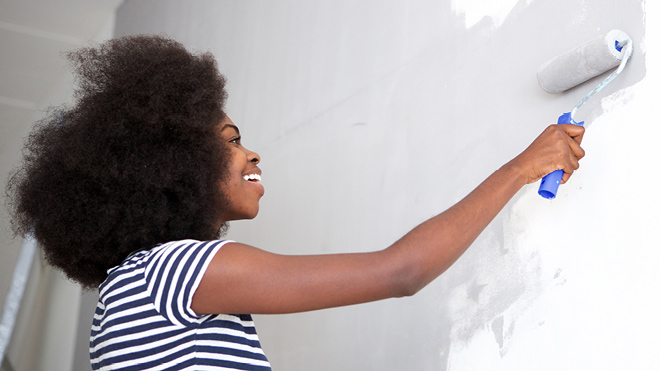
11 Ways To Pay for Large Home Improvements
When financing home projects, you have several options. Whether it's a HELOC, home improvement loan, cash or credit, we'll help you choose the option that works best for your budget.
You're not alone if you're looking for ways to pay for home improvements. Due to higher mortgage interest rates, more homeowners are deciding to renovate, expand and build instead of moving into a new home.
Expenses on U.S. home improvements totaled $566 billion in 2022, as estimated by the site Statista. Per household, 2023 spending added up to $13,667 and an average of 11.1 projects, according to contractor-review site Angi's List. These are increases over past years, and 2024 likely won't differ much.
Home improvements can range from upgrading the electrical and plumbing systems to adding space for a baby to remodeling a bathroom or kitchen. Homeowners are turning to home equity lines of credit, home improvement loans, credit cards, personal loans, and various governmental and nonprofit loans and grants. The best way to finance home improvement depends on your situation.
Home Improvement Financing Options
- You can pay for home improvements with cash, credit, loans or grants.
- Some loans rely on your home equity, or how much you own of your home.
- Home equity loans and lines of credit typically use your home as collateral, which means if you don't repay the loan, you could lose your home.
- Personal loans, credit cards and some government loans do not use your home as collateral.
1. Cash From Savings
If you've saved a serious stash of cash in a savings account, money market account or CD, you may be able to pay for repairs out of pocket. But consider whether you can spare the savings.
Cash Pros:
- No interest charges, fees or monthly payments.
- Contractors who prefer cash over credit cards may offer a discount.
Can mix with other approaches, such as a loan or credit card.
Cash Cons:
- Big projects require super-sized savings accounts.
- Can deplete your rainy-day funds.
You'll still need to keep several months of emergency funds saved for any potential job loss or surprise expense. If your home improvement project is planned and not an emergency repair, it may not justify dipping into your emergency fund.
2. Home Equity Line of Credit (HELOC)
A Home Equity Line of Credit allows you to borrow against your home equity up to a specified limit. It's an open-ended line of credit, which means you can access money when needed instead of borrowing the whole amount at once. With a HELOC, you can borrow, repay and borrow again from a revolving line of credit.
A HELOC has two periods: First, a draw period, during which you draw on the loan and are typically only required to pay interest, although you can make additional payments toward principal — the amount you borrowed. (At BECU the minimum payment due is interest only or $100, whichever is greater.) The repayment period follows, during which the revolving line of credit is closed and you repay the principal and interest.
HELOC Pros:
- You can borrow money, pay it back with interest and borrow it again during the draw period.
- Variable and fixed-rate options are available.
- Variable rate option may lead to lower monthly payments if rates decrease.
- You make interest-only payments during the initial draw period.
Your home equity acts as built-in collateral.
HELOC Cons:
- Variable rate options could lead to higher monthly payments if rates increase, or unpredictable payments with any rate change.
- If you don't repay the debt, you could lose your home.
- Fees may include origination fees, annual account maintenance fees or early repayment penalties. (BECU doesn't charge these fees.)
3. Fixed-Rate Home Equity Loan
If you have significant equity in your home, you may be able to use that equity to borrow a lump sum of money from a lender with a home equity loan. (BECU doesn't offer home equity loans, although a fixed rate advance is an option with a BECU HELOC. A fixed-rate advance allows you to lock in your rate on any sum of $5,000 or higher up to the total amount of your loan.) The loan amount and interest rate a lender offers depends on your income, credit history and your home's market value.
Fixed-Rate Home Equity Loan Pros:
- Good for one-time major home renovation projects.
- Fixed interest rates lead to dependable payments.
- Typically has lower rates because it relies on your home equity.
- Your home acts as built-in collateral.
Fixed-Rate Home Equity Cons:
- If you don't repay the debt, you could lose your home.
- Additional fees and closing costs such as an appraisal of your home, state or local mortgage fees, taxes and other expenses.
- Loan qualification is required, including a good credit score, a low debt-to-income ratio, and meeting other lender requirements.
4. Cash-Out Refinance
Refinancing your mortgage replaces your current mortgage with a new one larger than your current mortgage balance. You receive the difference as a lump-sum cash payment.
Cash-Out Refinance Pros:
- Fixed-rate mortgage and adjustable-rate mortgage (ARM) options may be available.
- Cash-out sums are good for larger, one-time projects.
- Uses your home's equity.
Cash-Out Refinance Cons:
- New mortgage may extend your loan's term (how long you have to repay it).
- Your new payments may be higher if you refinance at a higher rate than your current mortgage.
- Not repaying debt could lead to home loss.
5. Home Improvement Loan
Some financial institutions or organizations offer loans specifically for home improvement. These loans can be secured or unsecured, depending on the lender. BECU's home improvement loan, for example, is not secured by the borrower's property.
Some home improvement loans can be used for any large home project, while others can only be used for specific projects, such as solar panel installations in New Mexico or increasing accessibility in Minnesota.
Home Improvement Loan Pros:
- A secured home improvement loan typically offers better rates than an unsecured loan.
- Special bank or credit union programs may be available to improve your home.
- You can borrow for medium-sized home improvement projects.
Home Improvement Loan Cons:
- Unsecured home improvement loans typically have higher rates than HELOC or other home equity loans.
- Typically feature lower loan amount limits compared with amounts relying on equity.
- The uses of this type of loan are restricted in some cases.
6. Personal Loan or Line of Credit
A personal loan is a fixed-rate, unsecured loan. Some lenders may allow you to use a personal loan or personal line of credit for home improvements while others, like BECU, require borrowers to use a specific home improvement loan for that purpose. Because no collateral secures the loan, loan rates can be higher than other home loans. You can get a personal loan through various lenders — credit unions, online banks and even peer-to-peer lenders — for various amounts.
Personal Loan Pros:
- Personal loans typically have lower interest rates than credit cards.
- Shorter repayment terms and lower loan amounts are good for smaller projects.
- Widely available without the need for home appraisal.
Personal Loan Cons:
- Typically features higher interest rates than HELOCs or home equity loans.
- You must have very good credit to qualify.
- Your interest may not be tax-deductible, even if you're using the money for a home renovation.
7. Credit Card
You might pull out the plastic for a very small project or emergency home repair. Before charging a repair or improvement to your credit card, compare all of your cards' annual percentage rates to find the lowest rate. Consider how quickly you can pay off the home improvement charges and how much interest you'll pay.
Credit Card Pros:
- You can earn a sign-up bonus, cash back, miles or points from your spending.
- Some credit cards offer a promotional introductory 0% APR on balances for a limited timeframe.
- Easy to use, particularly in an emergency.
Credit Card Cons:
- Credit cards may have the highest interest rates of all home improvement financing options.
- You must follow a card's rules to avoid interest and fees, even for an introductory rate.
- If you don't pay off charges, interest could wipe out any bonus or cash-back you've earned.
8. Tax Credits and Rebates
The new Inflation Reduction Act offers significant tax credits and rebates that can help defray the cost of expensive home improvements, particularly if you hope to upgrade your home's energy efficiency. Two home energy upgrade rebate programs should be available to Washington residents in 2024, according to the Washington State Department of Commerce: A home electrification and appliance rebate and a home energy efficiency rebate.
Inflation Reduction Act Tax Credits and Rebates Pros:
- Provides tax credits of up to 30% for clean electricity, heating, cooling and other energy upgrades.
- Rebate programs include point-of-sale rebates for home electrification measures such as heat pumps.
- Most rebates available to low- and moderate-income customers.
Inflation Reduction Act Tax Credits and Rebates Cons:
- Credits are broadly available, but only applicable after the work is done.
- Income limits on rebates.
- You must consult with a tax professional for tax credit guidance.
9. Federal Government Loans and Grants
Federal home improvement loans through the Federal Housing Administration or U.S. Department of Agriculture may be a low-cost option for some homeowners. You typically must qualify for these loans based upon factors such as income, age, property type and location, or your status as a veteran, rural resident or Native American.
Federal Government Loans and Grants Pros:
- Small, targeted loans for at-risk populations to increase livability.
- Some loans are available even to those with limited home equity.
- Some loans don't require using your home as collateral.
Federal Government Loans and Grants Cons:
- Not available to everyone.
- Loan amounts are limited and lower than other options ($25,000 or less).
- Limits on how the funds can be used.
10. Local Loans and Grants
City, state and county loans and grants vary based on your home and residency. For example, King County offers two loan programs for home improvements, including deferred loans and matching loan programs for those who qualify. The county also provides $9,000 grants to address emergencies for eligible individuals. The City of Seattle offers 0% interest loans and grants to low-income borrowers within the city limits, starting at $3,000.
Local Loan and Grant Pros:
- Smaller, targeted loans to help homeowners deal with emergencies.
- Flexible loan terms, matching loans, 0% interest loans and other creative options might be available.
- Loans available to low-income borrowers and others who qualify.
Local Loan and Grant Cons:
- Loans are typically only for specific uses.
- Only available to those who qualify.
- Some free home improvement programs can help with tasks such as weatherization.
11. Nonprofit Assistance
Some nonprofit organizations offer deferred loans, grants and free or low-fee home repair assistance (such as repairing a porch or replacing a broken door) to help you avoid debt. For example, nonprofit Sound Generations provides a Minor Home Repair program for homeowners who qualify due to age, disability or income. The organization also offers water-saving toilets and installation if you're eligible. Habitat for Humanity offers a variety of low-fee fixes and deferred loans for King and Kittitas County homeowners.
Nonprofit Assistance Pros:
- Can help with minor or emergency repairs or projects.
- An option if your credit history, low home equity or income make other options unavailable.
Nonprofit Assistance Cons:
- Doesn't generally cover large home improvement projects.
- You may be able to apply to some organizations for deferred loans and grants for more expensive repairs.
How Much Do Home Renovations Cost?
Home renovation costs depend on the house and homeowner. A U.S. Census report released in 2023 found that new owners of older homes spent an average of $3,900 annually, a median of 1.5% of the home's value. Much of this could be due to deferred maintenance or personalizing a home.
Owners who lived in older homes for at least 10 years spent about $1,500 annually, the report found. On average, owners of older homes spent $4,100 on all home improvement projects between 2019 and 2021.
Homeowners mostly spent money on plumbing fixtures, flooring, ceilings and walls. Major renovations included bathroom remodeling, kitchen remodeling and adding a room.
When Is It a Good Idea to Finance Home Renovations?
It can be a good idea to finance home renovations if:
- Your home is facing an emergency that threatens safety or health.
- You don't have enough money saved and a renovation is urgent (needs to be done in the next year).
- The home renovations will expand space, improve efficiency or otherwise make your home more livable over the long term.
- You plan to live in your home for a long time, and the cost will be averaged out over time.
- The renovations increase your home's resale value.
Save Money on Home Improvement Financing
The easiest way to save money is to spend and borrow less overall. You'll repay less interest and potential fees if you borrow a lower amount. You may be able to lower your home improvement costs if you:
- Decide on wants versus needs: Some renovations are necessary to prevent further damage, while others are cosmetic and optional. Decide what can be paid for today versus paid off tomorrow.
- Get bids in advance: Get various estimates to understand how much you should borrow. Borrowing too much money leads to more interest payments.
- Decide to do more work yourself (DIY): Take care of projects yourself instead of hiring a professional if the changes are achievable and safe for a homeowner to do (such as repainting rooms).
- Shop for the best interest rate: Compare interest rates at different lenders to find the lowest rate.
- Shop for low fees: Compare fees between lenders, including closing costs and any early repayment fees for a home equity loan.
What Should I Consider When Financing Home Improvements?
You should consider multiple factors when financing home improvements, including:
- Amount you can borrow: Each lender sets a minimum and maximum amount you can borrow. Use your home improvement cost estimate to choose the lender with the needed amount.
- APR: The annual percentage rate is your interest rate expressed at the annual level or the cost you pay annually for the loan or credit card. A lower APR means you'll spend less to borrow. With a home equity loan, APR includes points, fees and other charges.
- Loan length: How long will you be repaying your loan? Will you be repaying it after your income may be reduced in retirement? What is the cost of your home improvement decision over time?
- Loan penalties and costs: What additional costs could you pay now or in the future? For example, are there closing costs for the home equity line of credit? Is an annual maintenance fee charged while the HELOC is open? Some loans also charge prepayment penalties if you pay off or close an account early.
The above article is intended to provide generalized financial information designed to educate a broad segment of the public; it does not give personalized financial, tax, investment, legal, or other business and professional advice. Before taking any action, you should always seek the assistance of a professional who knows your particular situation when making financial, legal, tax, investment, or any other business and professional decisions that affect you and/or your business.




